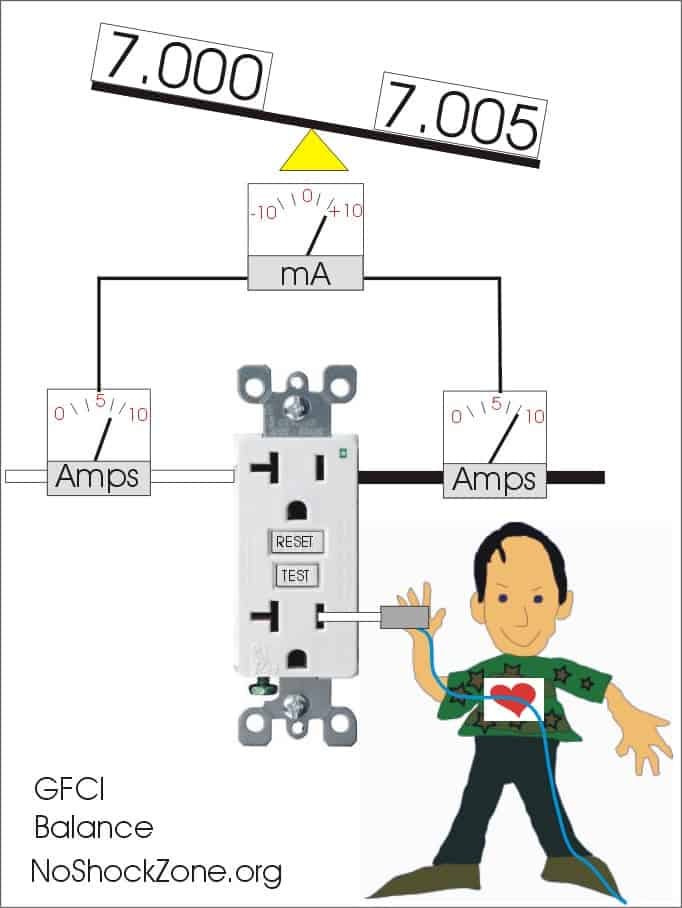Can you feel a shock from a GFCI?
A GFCI doesn't protect you from feeling a shock. It protects you from getting killed!
Dear Mike,
I felt a tingle from my RV when it was plugged into a 20-amp GFCI outlet at my friend’s cottage. He opened up the outlet box and we found there wasn’t a ground wire connected to it. This is a pretty old building that he says didn’t have grounded outlets to begin with, but an electrician replaced some of them with GFCI outlets. Is this safe or legal? Doesn’t a GFCI outlet need a ground to work? And why did I get shocked? Is the GFCI shocking me, or what? —Karl
Dear Karl,
Yes, a GFCI (Ground Fault Circuit Interrupter) can seem to be a riddle wrapped in a mystery inside an enigma. But it’s actually pretty simple once you understand what the GFCI is there to do. A GFCI is not there to keep you from getting shocked … it’s there to keep you from being electrocuted.
“A GFCI is not there to keep you from getting shocked … it’s there to keep you from being electrocuted.” —Mike Sokol
That’s right, folks. A GFCI doesn’t need a ground wire to protect you from being electrocuted (killed). But it does need a ground wire to keep you from feeling a shock. Let’s do a quick breakdown of how a GFCI works and why it’s permissible to install one without a ground wire.
A GFCI is really an electronic balancing scale that measures the amount of current going out and compares it to the amount of current returning to it. So, in my example, there’s supposed to be 7.000 amperes of current going out of the hot conductor (on the right), and if nothing’s wrong there will be the same 7.000 amperes of current returning to the neutral conductor.
Danger, Will Robinson…
But let’s say our less-than-careful cartoon guy sticks a screwdriver in the hot contact while standing on wet dirt. He now has 5 mA (milliamperes) of current flowing into his hand and out his feet. And, of course, his heart is right in the middle of the current flow. That adds up to 7.005 amperes of current going out of the outlet, and only 7.000 amperes returning to it on the neutral conductor.
This extra 5 mA (0.005 amperes) of current difference is enough to trip the electronic teeter-totter circuit inside of every GFCI, which causes it to open up its internal contacts, shutting off the power. Also note that 5 mA of current through you should not be sufficient to cause injury or death by electrocution. However, 5 mA is a pretty healthy shock, and even 1 mA is usually noticeable. That’s likely the amount of fault current you describe as a tingle.
Note that there’s no ground wire currents being measured by the circuitry inside of the GFCI. It’s only comparing the outgoing current with the return current, and will trip if the difference exceeds 5 mA. That’s how it knows the current is going somewhere it shouldn’t, which could be you touching something plugged in with a hot-skin voltage while making contact with a grounded object (like the earth). With me so far?
Does a GFCI need a ground wire?
Now, because the GFCI is actively working to protect you from getting more than a 5 mA shock, code allows you to install one WITHOUT a ground wire. That’s right, if you’re upgrading the electrical outlets in an older home that doesn’t have ground wiring, it’s permissible to install a GFCI receptacle without a ground, as long as you put the little sticker that came with it on the outlet cover that states “No Equipment Ground.”
It’s NEVER permitted to install a standard “grounded” outlet without a ground wire, nor is it permissible to do a bootleg jumper between the neutral and ground screws on the back of the outlet to create a sort of ground (that’s why it’s called a “bootleg” ground). However, I should state that it’s still best practice to install a proper EGC ground wire (Equipment Grounding Conductor) for a GFCI protected outlet whenever possible.
Where does the shock come from?
But where is this shocking voltage coming from if not the GFCI? Well, it usually comes from normal leakage currents inside of your RV’s electrical system. As I’ve written many times before, anything you plug into an electrical outlet leaks a little current to its chassis, the maximum amount of which is regulated by UL and other code bodies. So you can expect there to be 1 mA to 3 mA of leakage to chassis ground just from your converter/inverter, and older microwaves often leak 1 mA or more of current. Same goes for refrigerators, power strips with surge protection, home entertainment systems, etc. Of course, you could also have something really broken like a failed electric water heater element, which can create 1 to 3 amperes of fault current into the water itself which ends up in the RV chassis.
All of these leakage currents are additive. That’s why it’s possible to exceed the 5 mA on the GFCI without anything being wrong. And that’s also why plugging an RV into a grounded 20-amp GFCI outlet can result in random tripping. The GFCI only looks at the total leakage current before it trips.
How is this hot-skin voltage created?
As far as feeling a shock, if there’s no ground wire in the outlet to drain away these small leakage currents, they turn into stray voltage on the chassis, which the RV industry calls a hot-skin. For these kinds of fault currents it typically rises to around 1/2 of the line voltage, so you can expect to have a 60-volt hot-skin in this case, but with only a few mA of fault current available to shock you.
So let’s wrap this package up with a bow. Yes, it’s permissible according to code for your friend’s electrician to “upgrade” his cottage with ungrounded GFCI outlets. But if you plug your RV into one, it’s also possible for you to feel a shock while touching anything metal on the RV while standing on damp ground. If the GFCI is operating properly it should trip if the leakage current through you exceeds 5 mA, which is below the 10 mA threshold of really dangerous currents that can electrocute you.
And this is why you should test all GFCIs for proper operation at least once a season, and preferably once a month as recommended on the GFCI itself. If it’s installed without a ground then the circuitry in the GFCI itself is the only thing protecting you from being electrocuted (killed by electric shock) if something goes wrong, but it doesn’t stop you from feeling a shock. Hope this makes sense.
Let’s play safe out there…. Mike












Well written Mike, thank you